“This radically new approach is perhaps most vividly apparent in Cézanne’s landscapes and even in some of his still lifes, where a mere patchwork of textures coloured shapes is worked into a picture, upon which the eye and mind can rest and gradually unravel shapes and forms, perspective, etc in the normal way. This process can also be seen in Cézanne’s many studies of Mont St Victoire,…”
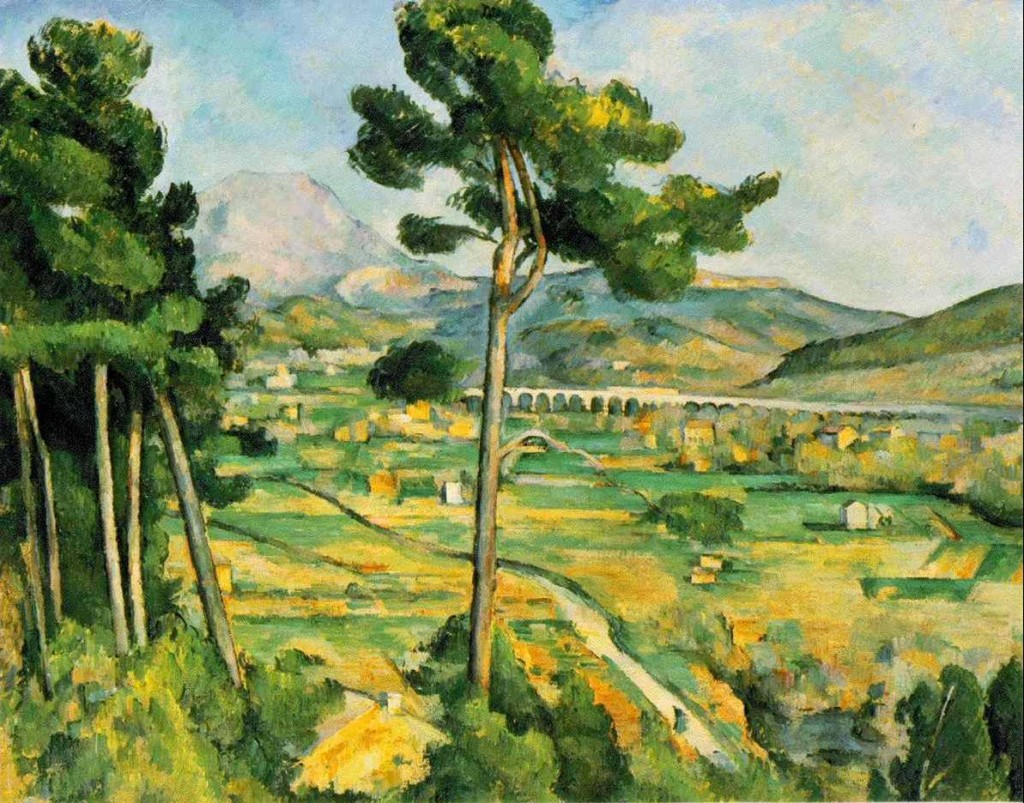
Cezanne. Mont Sainte-Victoire 1885-87. "I must get close to reality. I want it whole," Cezanne once told a friend. He had a romantic's lust for the natural world, tempered by a classicist's sense of proportion. Everywhere he sought to uncover solid, durable forms. Mont Sainte-Victoire particularly inspired him, and he painted the massive ridge near Aix at least sixty times.
…Like the impressionists, whom he met in Paris, Cezanne flung himself against the tide of current artistic propriety. The taste of the times ran to paintings that told a story or personified an easily recognizable, and usually platitudinous sentiment. The annual Salons, the only large scale public exhibitions, were presided over by juries from whom the anecdotal insipidities: “Return From a Bear Hunt During the Stone Age”, or “Little Bootblack in London” , represented the best in modern art.
Paintings of this kind aimed above all at an easy pictorial thrill that would titillate the salon visitor without shocking them. Accordingly, erotic or violent subjects were placed at some suitably historical remove and reality’s rough edges painted away. Surface gloss was everything; one can imagine how Cezanne, with his insistence on the essence of appearance, must have loathed such fashionable painting. “I must work,” he once wrote to his mother, “but not to achieve a final polish, which is for the admiration of imbeciles.”
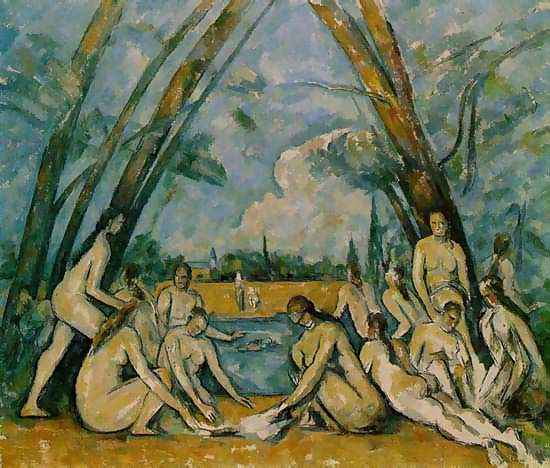
Cezanne. The Great Bathers. 1898-1905. In this picture, Cezanne completely integrated human form and landscape: the delicately colored nudes are as rooted as the trees that soar above.
Call it making a poor first impression. Forced to exhibit outside the Salon, the impressionists were to challenge, and to a large extent change, this creatively paralyzing situation, but only after a terrible struggle. Contemporary reviewers hurled vilifications at them because their new vision brought so many comfortable , accepted ideas about art, and eventually about society, into question. It was natural for Cezanne to make common cause with them, but he stayed very much on the fringes of the movement and finally moved away altogether. Still, the technical experiments of the impressionists and the importance placed on working directly from nature would be of great value to him.
“What really made artists like Cezanne, Picasso and Matisse so important is that they pushed open a freshly opened door—they realised and exhaustively explored the fact that any picture can be reduced to a merel mass of textured shapes of colour—or shapes of textured colour—and once any visual view is translated into such a perspective, and regarded in this way, one merely needs [the artist’s task is] to recreate the particular aggregation or patchwork of textured and coloured shapes in order to depict the scene in question. To an extent, this attitude is implicit to most Impressionism and later, this same impulse opened the door to abstract art.”
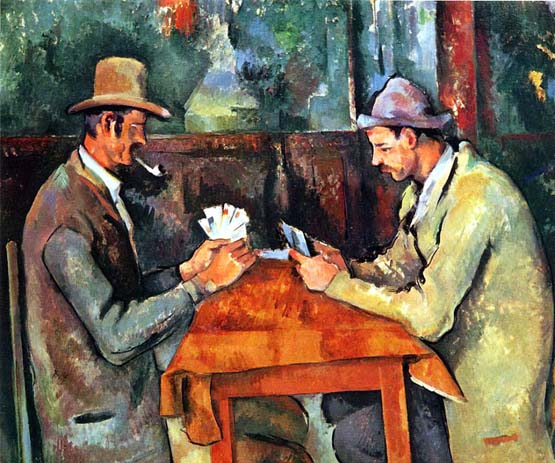
Cezanne. The Card Players. 1892. "The abstract side of Cézanne's art has always been given due weight. It was amusingly emphasized by Ambroise Vollard who, after sitting many times for his portrait, asked how it was getting on. Cézanne's reply: "I am not displeased with the shirt-front" seemed to suggest that the human element did not enter into his calculations, that he was simply concerned with planes and gradations of color. On the other hand, his several self-portraits give a remarkable sense of character and towards 1890 there are other signs of his interest in the aspect of human beings, as for example the five versions of 'The Card Players' produced during this period at Aix. The Louvre version, reproduced here, with two players (and a bottle between them to mark the center of the symmetrically balanced composition) could be looked on in the abstract as a magnificent rendering of solid forms, given their appearance of structure by the gradated areas of the thinly applied color. But the fact remains that these are not abstractions but peasant card players in his native Provence. "
“This was a breakthrough in art because it meant that the focus then fell mostly on creating pictures as composites of shape and colour rather than on painting ‘things,’ which are not real as separate things anyway, but which can be legitimately deconstructed into mere aggregations of shape, colour and texture in our world. They are not really ‘things’ in the normally accepted sense, but are simply discontinuities against a background.” (Peter Morrell )
During the Franco-Prussian War, which bled Paris dry, Cezanne and his young mistress, Hortense Ficquet, took refuge in L’Estaque, near Marseilles, partly to escape conscription and partly to conceal their liaison from Cezanne’s father. There, fascinated by the colors and forms along the rocky mediterranean coastline, he began to paint landscapes.
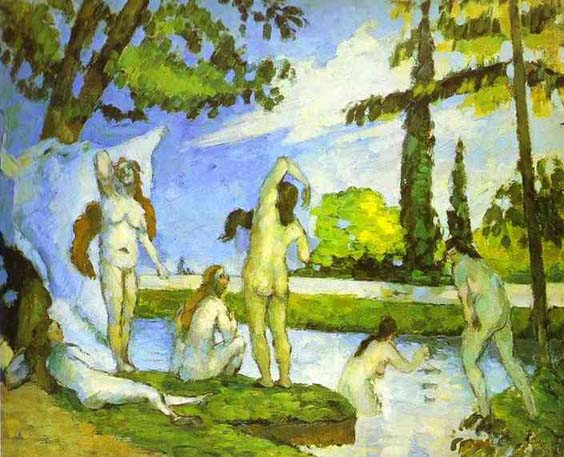
Six Women bathing. 1874. "Bathers were another of Cézanne's themes. Women bathers are usually presented in large pyramidal groups, overlapping, mostly with their backs to the viewer. His men generally face forward, almost in a frieze. They are individuals in the same scenery, neither interacting nor overlapping. There is no eye contact between any of them. Cézanne's on
eal passion was his art, but that passion was never revealed on the canvas itself."This direct experience with nature was immeasurably deepened and refined when he moved back up to the Paris region and spent two years working in the company of Camille Pissarro at Pointoise and Auvers. “Only paint with three primary colors and their immediate derivatives,” Pissarro told him. Accordingly, Cezanne began to lighten the somber tones of his palette and, when applying large areas of color to the canvas, to abandon his fluid brush stroke for a more stippled effect, using a special knife like the one Pissarro favored. In this, the impressionist way, he began to construct images created directly from nature by means of painstakingly graded touches of color. it was an easygoing but crucial apprenticeship, and one of the few things Cezanne appears not to have regretted. In his old age he told a young admirer, the painter Emile Bernard, that up until then he had simply been wasting his time.

Cezanne. The Modern Olympia. 1874. "After the article appeared, the artist Gaston de Latouche wrote to Dr.Gachet who exhibited his Cezanne The Modern Olympia, that he was going to serve as a guard at the exhibition and he would keep an eye on his canvas, but he couldn't garantee its safety. One of the Paris Salon reviewers stated: "We have seen the exhibition by these impressionists on the boulevard des Capucines, at Nadar's. M.Monet, Pissarro, Mlle Morisot, etc., to have declared war on beauty."
The agonizing slowness characteristic of Cezanne’s method was by now fully apparent. One story has it that while Cezanne and Pissarro were working at some distance from wach other outside Auvers, a peasant took it upon himself to inform Pissarro he had “an assistant over there who isn’t doing a stroke of work”.
Such incomprehension also came from within the art world itself. When Cezanne exhibited with impressionists in 1874, the critics were quick to single Cezanne out as the worst of a bad bunch. The painting that earned him their scorn was his “Modern Olympia”, a strange but rather delightful, free fantasy that shows a woman lying on a couch, her veil being removed under the rapt gaze of a man resembling Cezanne himself. One critic welcomed this reverie as follows:
“On Sunday the public saw fit to sneer at a fantastic figure revealed to a drug addict under an opium sky. This apparition of naked pink flesh, thrust by a kind of demon into the smoky clouds, like a voluptuous vision in a corner of artificial paradise, proved too much for the most courageous, and M. Cezanne merely gives the impression of being a sort of madman who paints in delirium tremens.”
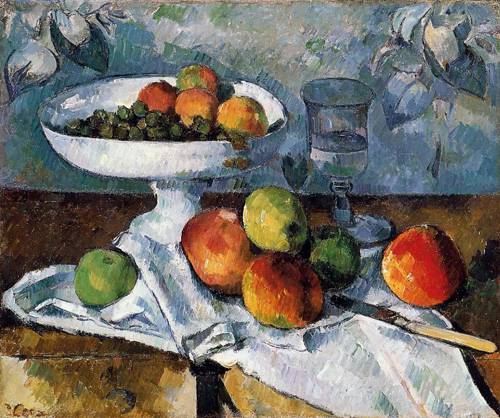
The fresh colors and apparently spontaneous brushwork of the Apples still lifes such as above from 1880 , belies the long, painstaking effort behind the artist's work. What occupied him endlessly was the careful modulation of color to create form. Discarding traditional methods of linear perspective, Cezanne wanted us to perceive the flat picture plane- the actual paint on the two dimensional surface.
Cezanne certainly did little to allay bourgeois disapproval. He was still living out of wedlock with Hortense, and, since he hadn’t dared tell his father how things stood, was supporting her and their infant son, Paul, on his small bachelor’s allowance. To hide his shyness he had cultivated a boorish manner: “I won’t shake your hand, Mr. Manet,” he once informed that fastidiously attired gentleman in his nasal Provencal twang. “I haven’t washed for a week.” But, above all, he became notorious for his avoidance of all company. In describing the Café de la Nouvelle-Athenes, one of the impressionists’ gathering places, the Irish born writer George Moore noted that he could not remember ever having seen Cezanne there- no doubt, he imagined, because the painter “was too rough, too savage a creature, and appeared in Paris only rarely. We used to hear about him- he used to be met on the outskirts of Paris wandering about the hillsides in jackboots. As no one took the least interest in his pictures, he left them in the fields.”

Onions and Bottle. 1895. Cezanne wanted us to perceve the flat picture frame. This was a radical approach, and in later arrangements , such as Onion and Bottle, the objects appear simultaneously distant and near, producing a "flat depth"
“This new art reveals what we do when we look at a real landscape—the new artist has recreated the same visual process, the same mental process of discernment that we engage in when looking at our world. The nature and functioning of our vision means that we see both a blurred background of forms and colours and also individual ‘things’ placed upon that background; we see both. But in the older formalised art, all things are depicted as things rather than in a blur. Thus, it was a deficient and inaccurate system in certain respects.
Impressionism sought, in its way, to correct those deficiencies by using a blurred and fuzzy way of depicting everything, not just backgrounds, but including also ‘things’ themselves; a blurring of shape borders became acceptable. Matisse and Picasso then took this all a stage further into distortion of shape and colour and greater abstraction. Yet, even with them, there remains the same basic approach as that of Cezanne and Monet, Sisley, Seurat, etc. ( Peter Morrell )
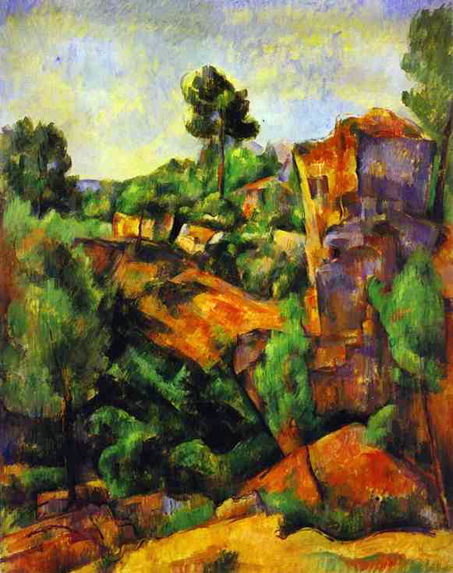
Canyon of Bibemus. 1898."Cézanne understood that a painting could not really do its subject justice. He knew that colors in nature and their combination with natural light could never be truly reproduced. He saw himself as an interpreter who had to accept the limitations of the medium and tried to transfer the images onto canvas the best way he could. He attempted to bridge the natural and artistic worlds. Hence Cézanne's works, in comparison with the paintings of many other Impressionists, only make sense as a whole, not in snippets, as the brush strokes and colors are meant to be interdependent on one another. This is especially true for pictures painted in the latter part of his career, when he used color in short strokes or in almost mosaic patches, all of equal intensity, throughout an entire painting. In his striving for perfection, this meant retouching the entire picture to recreate the all-important harmony."
… “In 1873 Claude Monet brought up once again the idea of opening a group exhibition at their own expense. An active campaign to recruit participants began among the artists. Pissarro invited Cezanne, although the others hardly agreed to his participation, as they feared that the public might be outraged by his canvases. But Pissarro was so convicting that his friend was finally accepted.
Degas hoped that Edouard Manet would join the group, but the painter had no intention of doing so. One of the reasons given when he was invited to exhibit with others was : “I’ll never commit myself with M.Cezanne”. He believed that only participation in the Salon could bring real recognition….
…On April 25 an article appeared in the Charivari (satirical magazine), signed by Louis Leroy, which under the title “Exhibition of the Impressionists”summed up the attitude of both its author and the general public. “Oh, it was indeed a strenuous day, ” wrote the critic, “when I ventured into the first exhibition on the boulevard des Capucines in the company of M. Joseph Vincent, landscape painter, pupil of Bertin (the academic master), recepient of medals and decorations under several governments! “Upon entering the first room, Joseph Vincent received an initial shock in front of the Dancer by M. Renoir. ‘What a pity’, he said to me, ‘that the painter, who has the certain understanding of color, doesn’t draw better; his dancer’s legs are as cottony as the gauze of her skirts.’…
…’Then, very quietly, with my most naive air, I led him before the Ploughed Field by M.Pissarro. At the sight of this astounding landscape, the good man thought that the lenses of his spectacles were dirty. He wiped them carefully and replaced them on his nose.
‘By Michalon!’ he cried. ‘What on earth is that?’ ‘Those furrows? That frost? But they are palette scrapings placed uniformly on a dirty canvas. It has neither head nor tail, top nor bottom, front nor back.’ ‘Perhaps.. but the impression is there’ Well, it’s a funny impression!..’





 COMMENTS
COMMENTS